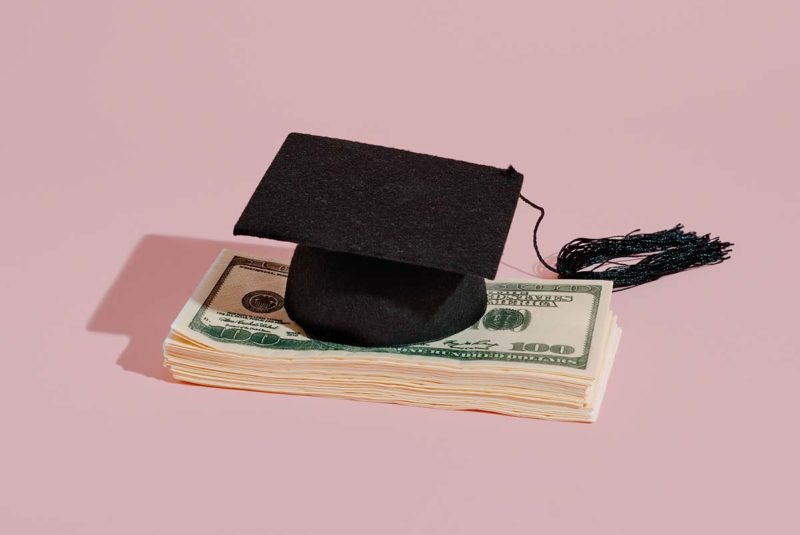While your higher education was invaluable, the residual student loan debt may feel overwhelming, haunting you like a ghost. Many student loan borrowers look for creative solutions to banish their debt – but it isn’t always easy.
Student loans eat into your budget and incur interest throughout a loan’s lifetime. And if you can’t pay your student loan debt, you’ll go into loan default, which means your credit score will drop and your loan servicer can take you to court.
Quick-fix options to legally avoid repaying student loans, like filing for bankruptcy, are difficult to pull off and unlikely. But don’t get spooked! There are student loan forgiveness programs, deferments and strategies to help make repayment easier.
Let’s explore a few of those solutions for federal student loans and figure out which option is right for you.
Loan Forgiveness Programs
There are two federal loan forgiveness programs that can rid you of federal student debt. They are the Teacher Loan Forgiveness program and the Public Service Loan Forgiveness program. Eligibility for both these programs is determined by occupation.
Student loan forgiveness is an excellent way to eliminate federal student aid debt. It’s designed to alleviate the student loan burden for teachers and public servants. While these programs can be incredibly helpful, there are a few things to note before applying for loan forgiveness.
First, both student loan forgiveness programs have specific requirements to qualify for forgiveness.
Second, the amount that’s forgiven may be subject to taxes. If you apply to either of these programs, prepare for a higher tax payment the year the loan is forgiven. That may sound scary, but the taxes will likely be minimal compared to the amount that’s forgiven, so it’s worth it in the long run.
And third, student loan forgiveness doesn’t hurt your credit score. The loans are removed from your credit report and no longer count against your debt to income (DTI) ratio.
Teacher loan forgiveness
Only Direct subsidized and unsubsidized loans and subsidized and unsubsidized Stafford loans are eligible for forgiveness under this program.
The teacher loan forgiveness program rewards teachers who have taught full-time at a low-income school for 5 consecutive academic years. The teacher must have a bachelor’s degree and full state certification.[1]
The amount of loan forgiveness depends on the subject you teach. Math, science or special education teachers may qualify for up to $17,500 in loan forgiveness. Teaching most other subjects will qualify a teacher for up to $5,000 in loan forgiveness.[1]
Public service loan forgiveness
The federal student loan forgiveness program for public servants helps those working full-time for an eligible employer. This forgiveness program only applies to Direct loans.
While it doesn’t cancel all debt, it rewards borrowers who have made monthly payments over 10 years (120 months).[2]
Eligible employees include:
- Government employees (including military)
- Nonprofit 501(c)(3) employees
- Full-time AmeriCorps volunteers
- Full-time Peace Corps volunteers[2]
Temporary Help: Deferment or Forbearance
Temporary debt-relief options won’t eliminate student loan debt, but they let you hit pause on your payments. Deferment and forbearance are helpful if you’re having trouble making payments and just need a little time to get back on your feet.
You can apply for a deferment or forbearance through the Department of Education at any time to help protect you from defaulting on your student loans. But what’s the difference between deferment and forbearance?
During forbearance, interest continues to accrue on your student loan balance, but during deferment, it doesn’t.
Income-Driven Repayment Plan
Federal income-driven repayment plans set affordable payments and forgive the remaining balance on your loan when the repayment term is up.
If you’re approved for a plan, the Department of Education will set a monthly payment that’s a percentage of your discretionary income. The percentage is determined by your family’s size and your income. At the end of the repayment period, generally 20 or 25 years, the remaining loan balance is forgiven.[4]
Disability Discharge
Disability discharge is an option if you are totally and permanently disabled. The Total and Permanent Disability (TPD) discharge relieves you from student loan repayment based on your disability.
To qualify for a TPD discharge, you’ll need to complete a TPD application and submit documentation from the Department of Veterans Affairs (VA), the Social Security Administration (SSA) or a doctor. The VA and SSA have their own qualifications for TPD. A doctor will have to confirm that you cannot work because of a physical or mental impairment that has lasted or will last at least 5 years or will result in death.[5]
Student Loan Consolidation and Refinancing
Federal student loan consolidation combines all your federal student loans into one loan with one monthly payment. The interest on the new, newly combined loan is the average of the interest on all your loans.
While you may end up making bigger monthly payments than you were used to with this option, it simplifies your life because you’re no longer keeping track of multiple payments. It’s just one payment a month. It also provides you with the option to extend the length of your loan repayment .[6]
Student loan refinancing won’t eliminate your student loans, but it can make paying them off more affordable. While you can’t refinance federal loans through the government, you can refinance them with a private lender. But, if you go this route you no longer have the benefits that come with federal loans like deferment or forbearance.
Private student loan refinancing lets you refinance federal and private student loans with a private lender. You may be able to get a lower interest rate and different loan terms (read: length of time to repay).
Employer Assistance
If you can’t find student loan relief from the Department of Education, ask your employer if they offer any repayment plans. Many employers now offer repayment plans or some other form of student loan relief as a job perk to attract and retain recent graduates.
Bankruptcy: The Last Choice
If you declare Chapter 7 or Chapter 13 bankruptcy, you may qualify for discharge from your federal student loans. However, filing for bankruptcy should be the last line of defense. It’s difficult to prove that your student loans are the reason for financial hardship and bankruptcy a negative impact on your credit report for 10 years.[7]
Student loans rarely qualify for bankruptcy discharge. Essentially, you have to prove that paying the loan(s) causes undue hardship to you and your family. The courts determine undue hardship when the borrower meets these requirements:
- Continuing to pay the loan would push the borrower below a minimal standard of living
- The hardship would endure through most of the loan repayment term
- The borrower made good faith efforts to pay the loan before filing[7]
If you can prove these three requirements, you should consider filing for bankruptcy. But filing for bankruptcy should be your final option only after you’ve tried everything else.
Who You Gonna Call? Loanbusters
Are your loans haunting you? Maybe you’re eligible for forgiveness, forbearance, deferment, refinancing or other options. You’re out of school, but you’ll need to do your homework to find the debt relief option that works best for you. Document your situation. Weigh your repayment options. And find debt relief.
The Short Version
- Student loan forgiveness doesn’t hurt your credit score. The loans are removed from your credit report and no longer count against your debt-to-income (DTI) ratio
- Quick-fix options to legally avoid repaying student loans, like filing for bankruptcy, are difficult to pull off and unlikely
- If you can’t pay your student loan debt, you’ll go into loan default, which means your credit score will drop and your loan servicer can take you to court
Federal Student Aid. “Teacher Loan Forgiveness.” Retrieved February 2022 from https://studentaid.gov/manage-loans/forgiveness-cancellation/teacher
Federal Student Aid. “Public Service Loan Forgiveness (PSLF).” Retrieved February 2022 from https://studentaid.gov/manage-loans/forgiveness-cancellation/public-service
U.S. Department of Education. “COVID-19 Emergency Relief and Federal Student Aid.“ Retrieved January 2023 from https://studentaid.gov/announcements-events/covid-19
Federal Student Aid. “Income-Driven Repayment Plans.” Retrieved February 2022 from https://studentaid.gov/manage-loans/repayment/plans/income-driven
Federal Student Aid. “Total and Permanent Disability Discharge.” Retrieved February 2022 from https://studentaid.gov/manage-loans/forgiveness-cancellation/disability-discharge
Federal Student Aid. “Student Loan Consolidation.” Retrieved February 2022 from https://studentaid.gov/manage-loans/consolidation
Federal Student Aid. “Discharge in Bankruptcy.” Retrieved February 2022 from https://studentaid.gov/manage-loans/forgiveness-cancellation/bankruptcy




